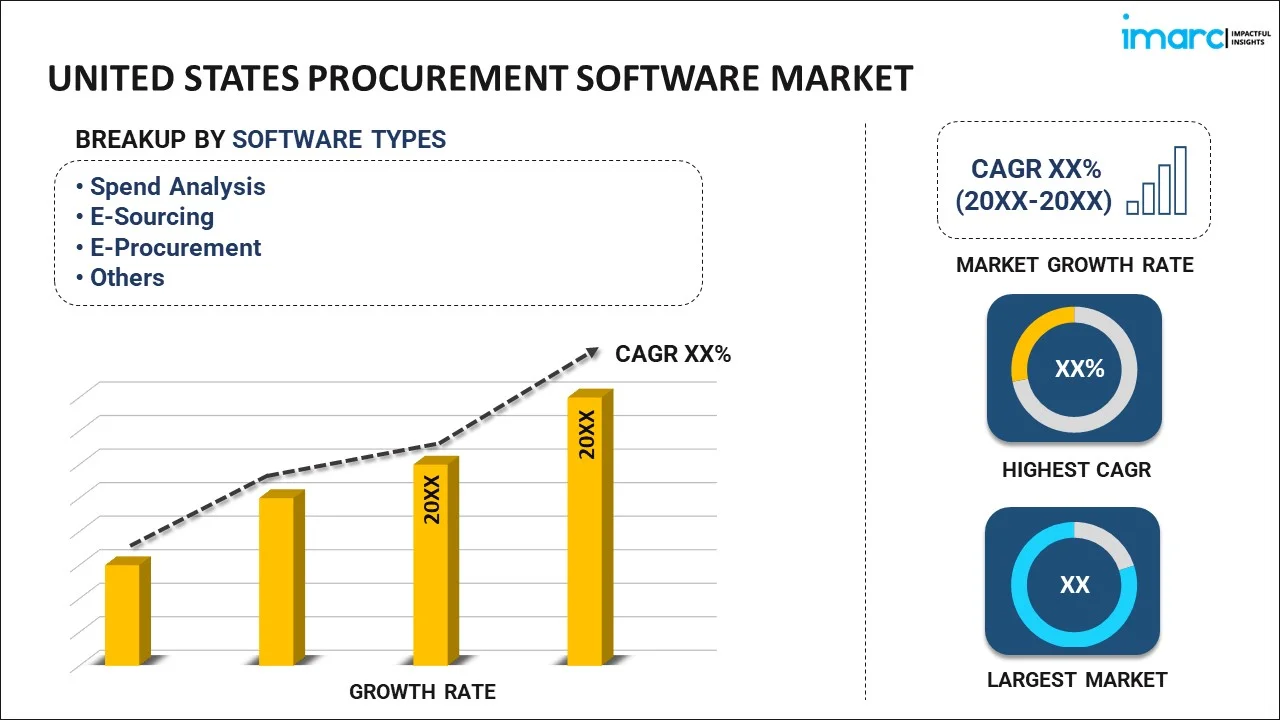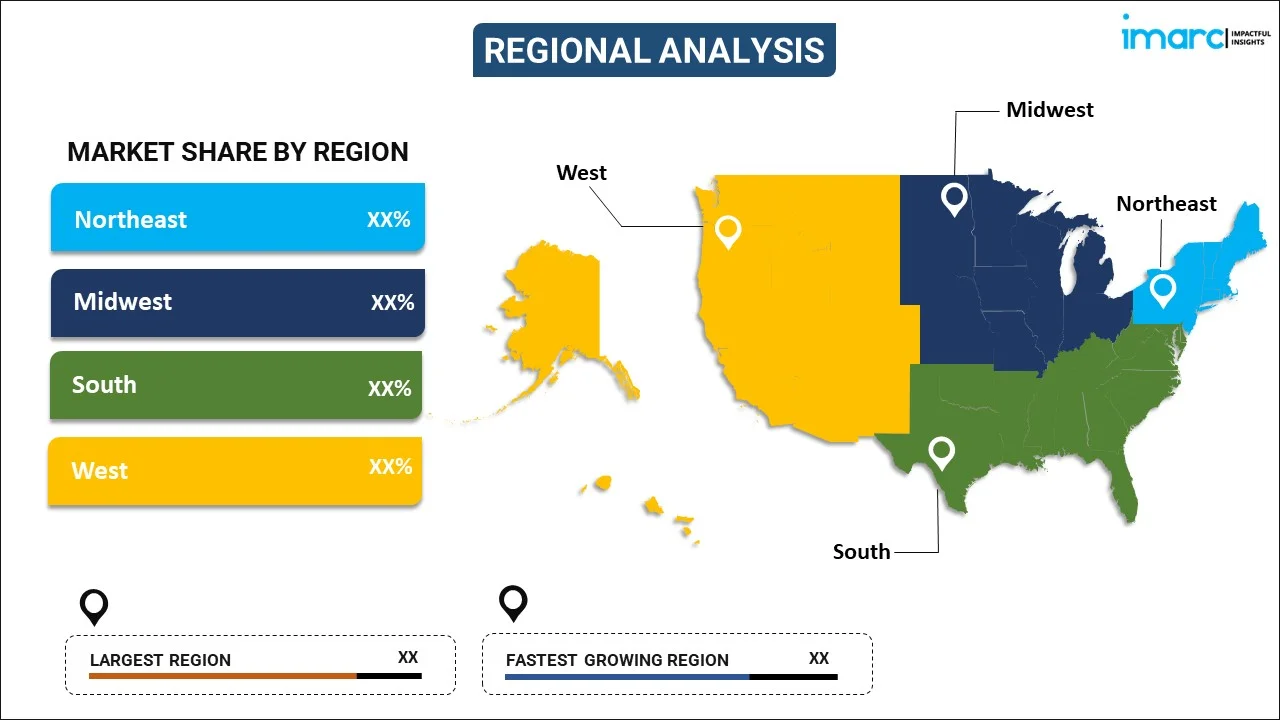
United States Procurement Software Market Report by Software Type (Spend Analysis, E-Sourcing, E-Procurement, Contract Management, Supplier Management, and Others), Deployment (Cloud-based, On-premises), Organization Size (Small and Medium-sized Enterprises, Large Enterprises), Vertical (Retail, Automotive, Travel and Logistics, Electronics, IT and Telecommunication, and Others), and Region 2024-2032
Market Overview:
United States procurement software market size is projected to exhibit a growth rate (CAGR) of 10.10% during 2024-2032. The increasing adoption of technology, the impact of the COVID-19 pandemic, a focus on cost optimization, escalating sustainability concerns, rapidly expanding e-commerce sector, integration of artificial intelligence (AI) and machine learning (ML), and supply chain disruptions are some of the primary factors influencing the market growth.
|
Report Attribute
|
Key Statistics
|
|---|---|
|
Base Year
|
2023
|
|
Forecast Years
|
2024-2032
|
|
Historical Years
|
2018-2023
|
| Market Growth Rate (2024-2032) | 10.10% |
Procurement software, a vital tool in modern business operations, serves as a digital solution designed to streamline and optimize the procurement process. It is developed using advanced programming languages and technologies, typically built on a robust database system. The software's primary purpose is to automate and centralize various aspects of procurement, from supplier management and sourcing to purchase orders and invoice processing. By integrating these functions into a unified platform, organizations can achieve greater efficiency, accuracy, and transparency in their procurement operations. It finds extensive applications across various sectors, as it enables organizations to efficiently manage their supplier relationships by providing a comprehensive view of vendor performance, pricing, and availability. Furthermore, procurement software facilitates strategic sourcing by analyzing supplier data, market trends, and historical purchase information, allowing businesses to make informed decisions and negotiate better deals. Additionally, it streamlines the creation and approval of purchase orders, reducing the likelihood of errors and delays. Furthermore, the software automates invoice processing, ensuring accurate and timely payment to suppliers, thereby improving cash flow management. The advantages of using procurement software are manifold, such as it enhances productivity by automating repetitive tasks, enabling procurement professionals to focus on more strategic activities. Additionally, it promotes cost savings by identifying opportunities for bulk purchases, negotiating better terms, and reducing maverick spending.
United States Procurement Software Market Trends:
The United States procurement software market is influenced by several key drivers, such as the increasing adoption of technology across various industries. Organizations are realizing the significance of efficient procurement processes, leading to a rising demand for software solutions that streamline purchasing, vendor management, and spend analytics. In line with this, the COVID-19 pandemic accelerated the need for digital transformation, with many companies seeking procurement software to enhance remote work capabilities and ensure business continuity, which is boosting the market growth. Additionally, the focus on cost optimization and savings in procurement operations is another key driver, with businesses recognizing the potential for software tools to reduce costs, improve supplier relationships, and enhance compliance. Moreover, the regulatory landscape plays a significant role, as procurement software is often utilized to ensure adherence to compliance standards and mitigate risks associated with supplier management, which is propelling the market growth. Apart from this, the growing trend towards sustainability and responsible sourcing has prompted organizations to seek software solutions that enable them to monitor and improve their supply chain sustainability practices, which is stimulating the market growth in the country.
United States Procurement Software Market Segmentation:
IMARC Group provides an analysis of the key trends in each segment of the market, along with forecasts at the country level for 2024-2032. Our report has categorized the market based on software type, deployment, organization size, and vertical.
Software Type Insights:

- Spend Analysis
- E-Sourcing
- E-Procurement
- Contract Management
- Supplier Management
- Others
The report has provided a detailed breakup and analysis of the market based on the software type. This includes spend analysis, e-sourcing, e-procurement, contract management, supplier management, and others.
Deployment Insights:
- Cloud-based
- On-premises
A detailed breakup and analysis of the market based on deployment have also been provided in the report. This includes cloud-based and on-premises.
Organization Size Insights:
- Small and Medium-sized Enterprises
- Large Enterprises
The report has provided a detailed breakup and analysis of the market based on the organization size. This includes small and medium-sized enterprises and large enterprises.
Vertical Insights:
- Retail
- Automotive
- Travel and Logistics
- Electronics
- IT and Telecommunication
- Others
A detailed breakup and analysis of the market based on vertical have also been provided in the report. This includes retail, automotive, travel and logistics, electronics, IT and telecommunication, and others.
Regional Insights:

- Northeast
- Midwest
- South
- West
The report has also provided a comprehensive analysis of all the major regional markets, which include the Northeast, Midwest, South, and West.
Competitive Landscape:
The market research report has also provided a comprehensive analysis of the competitive landscape in the market. Competitive analysis such as market structure, key player positioning, top winning strategies, competitive dashboard, and company evaluation quadrant has been covered in the report. Also, detailed profiles of all major companies have been provided.
United States Procurement Software Market Report Coverage:
| Report Features | Details |
|---|---|
| Base Year of the Analysis | 2023 |
| Historical Period | 2018-2023 |
| Forecast Period | 2024-2032 |
| Units | US$ Million |
| Scope of the Report | Exploration of Historical and Forecast Trends, Industry Catalysts and Challenges, Segment-Wise Historical and Predictive Market Assessment:
|
| Software Types Covered | Spend Analysis, E-Sourcing, E-Procurement, Contract Management, Supplier Management, Others |
| Deployments Covered | Cloud-based, On-premises |
| Organization Sizes Covered | Small and Medium-sized Enterprises, Large Enterprises |
| Verticals Covered | Retail, Automotive, Travel and Logistics, Electronics, IT and Telecommunication, Others |
| Regions Covered | Northeast, Midwest, South, West |
| Customization Scope | 10% Free Customization |
| Report Price and Purchase Option | Single User License: US$ 3699 Five User License: US$ 4699 Corporate License: US$ 5699 |
| Post-Sale Analyst Support | 10-12 Weeks |
| Delivery Format | PDF and Excel through Email (We can also provide the editable version of the report in PPT/Word format on special request) |
Key Questions Answered in This Report:
- How has the United States procurement software market performed so far and how will it perform in the coming years?
- What has been the impact of COVID-19 on the United States procurement software market?
- What is the breakup of the United States procurement software market on the basis of software type?
- What is the breakup of the United States procurement software market on the basis of deployment?
- What is the breakup of the United States procurement software market on the basis of organization size?
- What is the breakup of the United States procurement software market on the basis of vertical?
- What are the various stages in the value chain of the United States procurement software market?
- What are the key driving factors and challenges in the United States procurement software?
- What is the structure of the United States procurement software market and who are the key players?
- What is the degree of competition in the United States procurement software market?
Key Benefits for Stakeholders:
- IMARC’s industry report offers a comprehensive quantitative analysis of various market segments, historical and current market trends, market forecasts, and dynamics of the United States procurement software market from 2018-2032.
- The research report provides the latest information on the market drivers, challenges, and opportunities in the United States procurement software market.
- Porter's five forces analysis assist stakeholders in assessing the impact of new entrants, competitive rivalry, supplier power, buyer power, and the threat of substitution. It helps stakeholders to analyze the level of competition within the United States procurement software industry and its attractiveness.
- A competitive landscape allows stakeholders to understand their competitive environment and provides an insight into the current positions of key players in the market.
Need more help?
- Speak to our experienced analysts for insights on the current market scenarios.
- Include additional segments and countries to customize the report as per your requirement.
- Gain an unparalleled competitive advantage in your domain by understanding how to utilize the report and positively impacting your operations and revenue.
- For further assistance, please connect with our analysts.
 Inquire Before Buying
Inquire Before Buying
 Speak to an Analyst
Speak to an Analyst
 Request Brochure
Request Brochure
 Request Customization
Request Customization




.webp)




.webp)












